24 Epidemic modeling
24.1 Overview
There exists a growing body of tools for epidemic modelling that lets us conduct fairly complex analyses with minimal effort. This section will provide an overview on how to use these tools to:
- estimate the effective reproduction number Rt and related statistics such as the doubling time
- produce short-term projections of future incidence
It is not intended as an overview of the methodologies and statistical methods underlying these tools, so please refer to the Resources tab for links to some papers covering this. Make sure you have an understanding of the methods before using these tools; this will ensure you can accurately interpret their results.
Below is an example of one of the outputs we’ll be producing in this section.
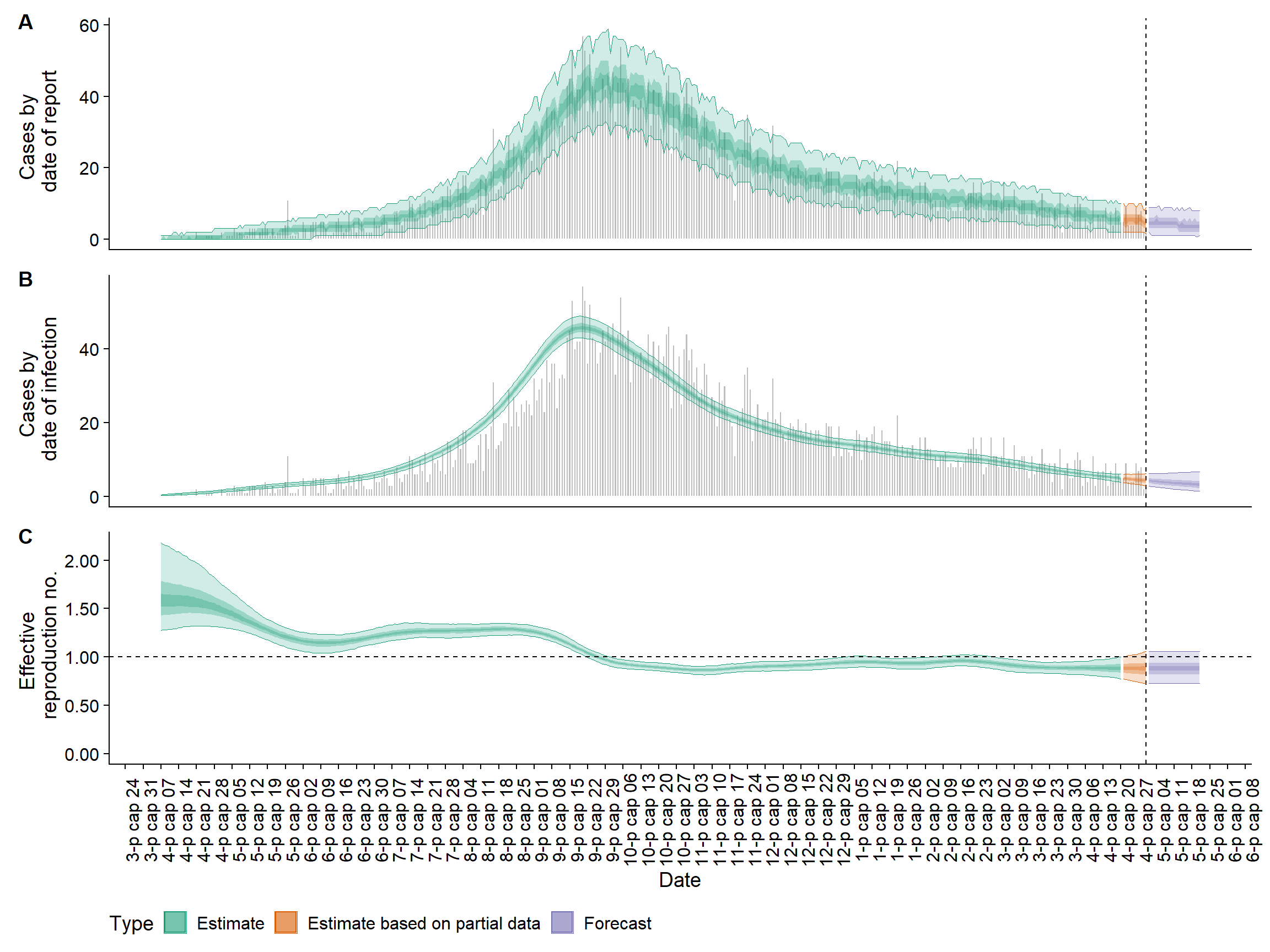
24.2 Preparation
We will use two different methods and packages for Rt estimation, namely EpiNow and EpiEstim, as well as the projections package for forecasting case incidence.
This code chunk shows the loading of packages required for the analyses.
In this handbook we emphasize p_load() from pacman, which installs the package if necessary and loads it for use.
You can also load installed packages with library() from base R. See the page on [R basics] for more information on R packages.
pacman::p_load(
rio, # File import
here, # File locator
tidyverse, # Data management + ggplot2 graphics
epicontacts, # Analysing transmission networks
EpiNow2, # Rt estimation
EpiEstim, # Rt estimation
projections, # Incidence projections
incidence2, # Handling incidence data
epitrix, # Useful epi functions
distcrete # Discrete delay distributions
)We will use the cleaned case linelist for all analyses in this section. If you want to follow along, click to download the “clean” linelist (as .rds file). See the [Download handbook and data] page to download all example data used in this handbook.
# import the cleaned linelist
linelist <- import("linelist_cleaned.rds")24.3 Estimating Rt
EpiNow2 vs. EpiEstim
The reproduction number R is a measure of the transmissibility of a disease and is defined as the expected number of secondary cases per infected case. In a fully susceptible population, this value represents the basic reproduction number R0. However, as the number of susceptible individuals in a population changes over the course of an outbreak or pandemic, and as various response measures are implemented, the most commonly used measure of transmissibility is the effective reproduction number Rt; this is defined as the expected number of secondary cases per infected case at a given time t.
The EpiNow2 package provides the most sophisticated framework for estimating Rt. It has two key advantages over the other commonly used package, EpiEstim:
- It accounts for delays in reporting and can therefore estimate Rt even when recent data is incomplete.
- It estimates Rt on dates of infection rather than the dates of onset of reporting, which means that the effect of an intervention will be immediately reflected in a change in Rt, rather than with a delay.
However, it also has two key disadvantages:
- It requires knowledge of the generation time distribution (i.e. distribution of delays between infection of a primary and secondary cases), incubation period distribution (i.e. distribution of delays between infection and symptom onset) and any further delay distribution relevant to your data (e.g. if you have dates of reporting, you require the distribution of delays from symptom onset to reporting). While this will allow more accurate estimation of Rt, EpiEstim only requires the serial interval distribution (i.e. the distribution of delays between symptom onset of a primary and a secondary case), which may be the only distribution available to you.
- EpiNow2 is significantly slower than EpiEstim, anecdotally by a factor of about 100-1000! For example, estimating Rt for the sample outbreak considered in this section takes about four hours (this was run for a large number of iterations to ensure high accuracy and could probably be reduced if necessary, however the points stands that the algorithm is slow in general). This may be unfeasible if you are regularly updating your Rt estimates.
Which package you choose to use will therefore depend on the data, time and computational resources available to you.
EpiNow2
Estimating delay distributions
The delay distributions required to run EpiNow2 depend on the data you have. Essentially, you need to be able to describe the delay from the date of infection to the date of the event you want to use to estimate Rt. If you are using dates of onset, this would simply be the incubation period distribution. If you are using dates of reporting, you require the delay from infection to reporting. As this distribution is unlikely to be known directly, EpiNow2 lets you chain multiple delay distributions together; in this case, the delay from infection to symptom onset (e.g. the incubation period, which is likely known) and from symptom onset to reporting (which you can often estimate from the data).
As we have the dates of onset for all our cases in the example linelist, we will only require the incubation period distribution to link our data (e.g. dates of symptom onset) to the date of infection. We can either estimate this distribution from the data or use values from the literature.
A literature estimate of the incubation period of Ebola (taken from this paper) with a mean of 9.1, standard deviation of 7.3 and maximum value of 30 would be specified as follows:
incubation_period_lit <- list(
mean = log(9.1),
mean_sd = log(0.1),
sd = log(7.3),
sd_sd = log(0.1),
max = 30
)Note that EpiNow2 requires these delay distributions to be provided on a log
scale, hence the log call around each value (except the max parameter which,
confusingly, has to be provided on a natural scale). The mean_sd and sd_sd
define the standard deviation of the mean and standard deviation estimates. As
these are not known in this case, we choose the fairly arbitrary value of 0.1.
In this analysis, we instead estimate the incubation period distribution
from the linelist itself using the function bootstrapped_dist_fit, which will
fit a lognormal distribution to the observed delays between infection and onset
in the linelist.
## estimate incubation period
incubation_period <- bootstrapped_dist_fit(
linelist$date_onset - linelist$date_infection,
dist = "lognormal",
max_value = 100,
bootstraps = 1
)The other distribution we require is the generation time. As we have data on
infection times and transmission links, we can estimate this
distribution from the linelist by calculating the delay between infection times
of infector-infectee pairs. To do this, we use the handy get_pairwise function
from the package epicontacts, which allows us to calculate pairwise
differences of linelist properties between transmission pairs. We first create an
epicontacts object (see Transmission chains page for further
details):
## generate contacts
contacts <- linelist %>%
transmute(
from = infector,
to = case_id
) %>%
drop_na()
## generate epicontacts object
epic <- make_epicontacts(
linelist = linelist,
contacts = contacts,
directed = TRUE
)We then fit the difference in infection times between transmission pairs,
calculated using get_pairwise, to a gamma distribution:
## estimate gamma generation time
generation_time <- bootstrapped_dist_fit(
get_pairwise(epic, "date_infection"),
dist = "gamma",
max_value = 20,
bootstraps = 1
)Running EpiNow2
Now we just need to calculate daily incidence from the linelist, which we can do
easily with the dplyr functions group_by() and n(). Note
that EpiNow2 requires the column names to be date and confirm.
## get incidence from onset dates
cases <- linelist %>%
group_by(date = date_onset) %>%
summarise(confirm = n())We can then estimate Rt using the epinow function. Some notes on
the inputs:
- We can provide any number of ‘chained’ delay distributions to the
delaysargument; we would simply insert them alongside theincubation_periodobject within thedelay_optsfunction. -
return_outputensures the output is returned within R and not just saved to a file. -
verbosespecifies that we want a readout of the progress. -
horizonindicates how many days we want to project future incidence for. - We pass additional options to the
stanargument to specify how long we want to run the inference for. Increasingsamplesandchainswill give you a more accurate estimate that better characterises uncertainty, however will take longer to run.
## run epinow
epinow_res <- epinow(
reported_cases = cases,
generation_time = generation_time,
delays = delay_opts(incubation_period),
return_output = TRUE,
verbose = TRUE,
horizon = 21,
stan = stan_opts(samples = 750, chains = 4)
)Analysing outputs
Once the code has finished running, we can plot a summary very easily as follows. Scroll the image to see the full extent.
## plot summary figure
plot(epinow_res)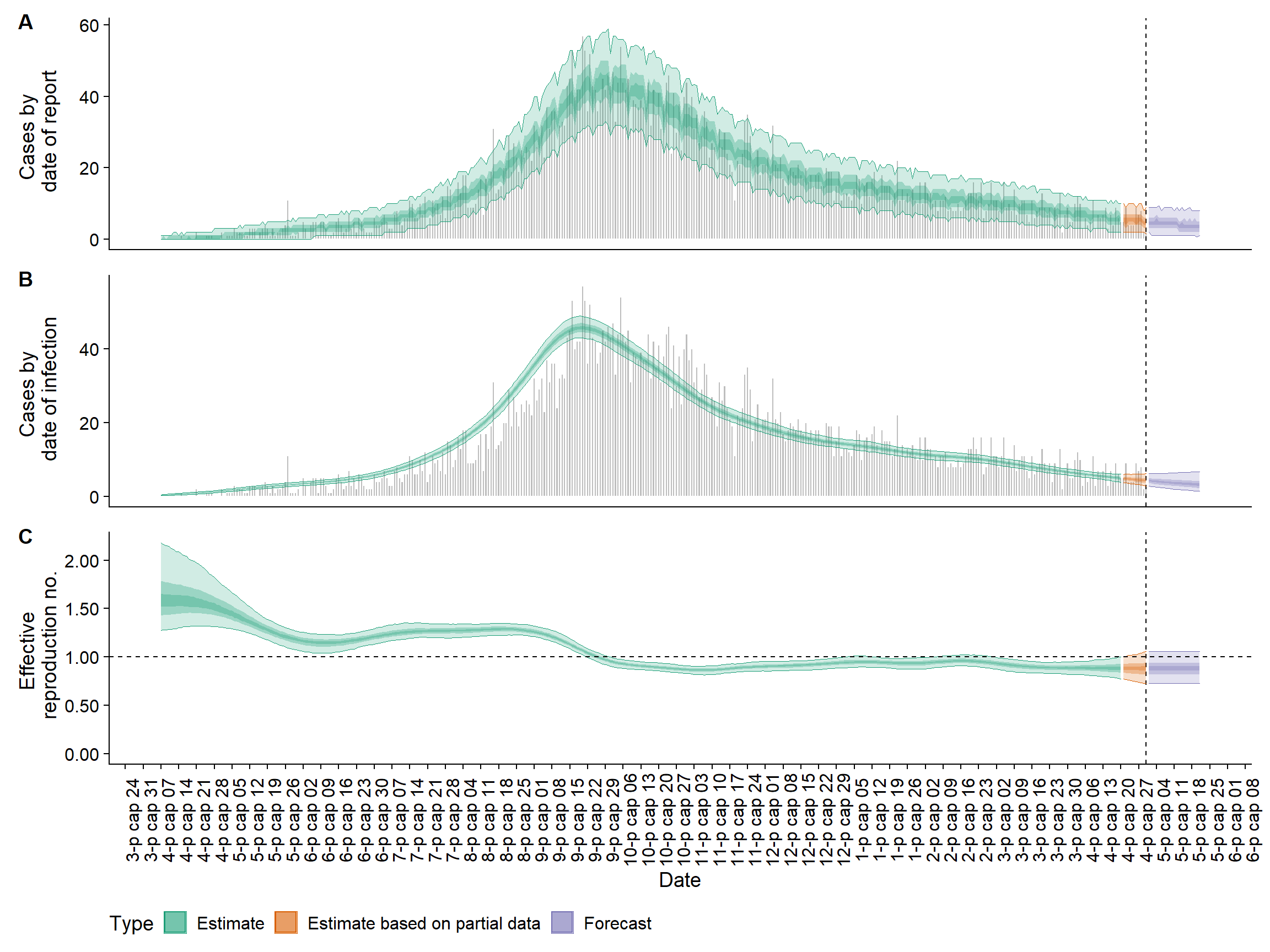
We can also look at various summary statistics:
## summary table
epinow_res$summary## measure estimate numeric_estimate
## 1: New confirmed cases by infection date 4 (2 -- 6) <data.table[1x9]>
## 2: Expected change in daily cases Unsure 0.56
## 3: Effective reproduction no. 0.88 (0.73 -- 1.1) <data.table[1x9]>
## 4: Rate of growth -0.012 (-0.028 -- 0.0052) <data.table[1x9]>
## 5: Doubling/halving time (days) -60 (130 -- -25) <data.table[1x9]>For further analyses and custom plotting, you can access the summarised daily
estimates via $estimates$summarised. We will convert this from the default
data.table to a tibble for ease of use with dplyr.
## extract summary and convert to tibble
estimates <- as_tibble(epinow_res$estimates$summarised)
estimatesAs an example, let’s make a plot of the doubling time and Rt. We will only look at the first few months of the outbreak when Rt is well above one, to avoid plotting extremely high doublings times.
We use the formula log(2)/growth_rate to calculate the doubling time from the
estimated growth rate.
## make wide df for median plotting
df_wide <- estimates %>%
filter(
variable %in% c("growth_rate", "R"),
date < as.Date("2014-09-01")
) %>%
## convert growth rates to doubling times
mutate(
across(
c(median, lower_90:upper_90),
~ case_when(
variable == "growth_rate" ~ log(2)/.x,
TRUE ~ .x
)
),
## rename variable to reflect transformation
variable = replace(variable, variable == "growth_rate", "doubling_time")
)
## make long df for quantile plotting
df_long <- df_wide %>%
## here we match matching quantiles (e.g. lower_90 to upper_90)
pivot_longer(
lower_90:upper_90,
names_to = c(".value", "quantile"),
names_pattern = "(.+)_(.+)"
)
## make plot
ggplot() +
geom_ribbon(
data = df_long,
aes(x = date, ymin = lower, ymax = upper, alpha = quantile),
color = NA
) +
geom_line(
data = df_wide,
aes(x = date, y = median)
) +
## use label_parsed to allow subscript label
facet_wrap(
~ variable,
ncol = 1,
scales = "free_y",
labeller = as_labeller(c(R = "R[t]", doubling_time = "Doubling~time"), label_parsed),
strip.position = 'left'
) +
## manually define quantile transparency
scale_alpha_manual(
values = c(`20` = 0.7, `50` = 0.4, `90` = 0.2),
labels = function(x) paste0(x, "%")
) +
labs(
x = NULL,
y = NULL,
alpha = "Credibel\ninterval"
) +
scale_x_date(
date_breaks = "1 month",
date_labels = "%b %d\n%Y"
) +
theme_minimal(base_size = 14) +
theme(
strip.background = element_blank(),
strip.placement = 'outside'
)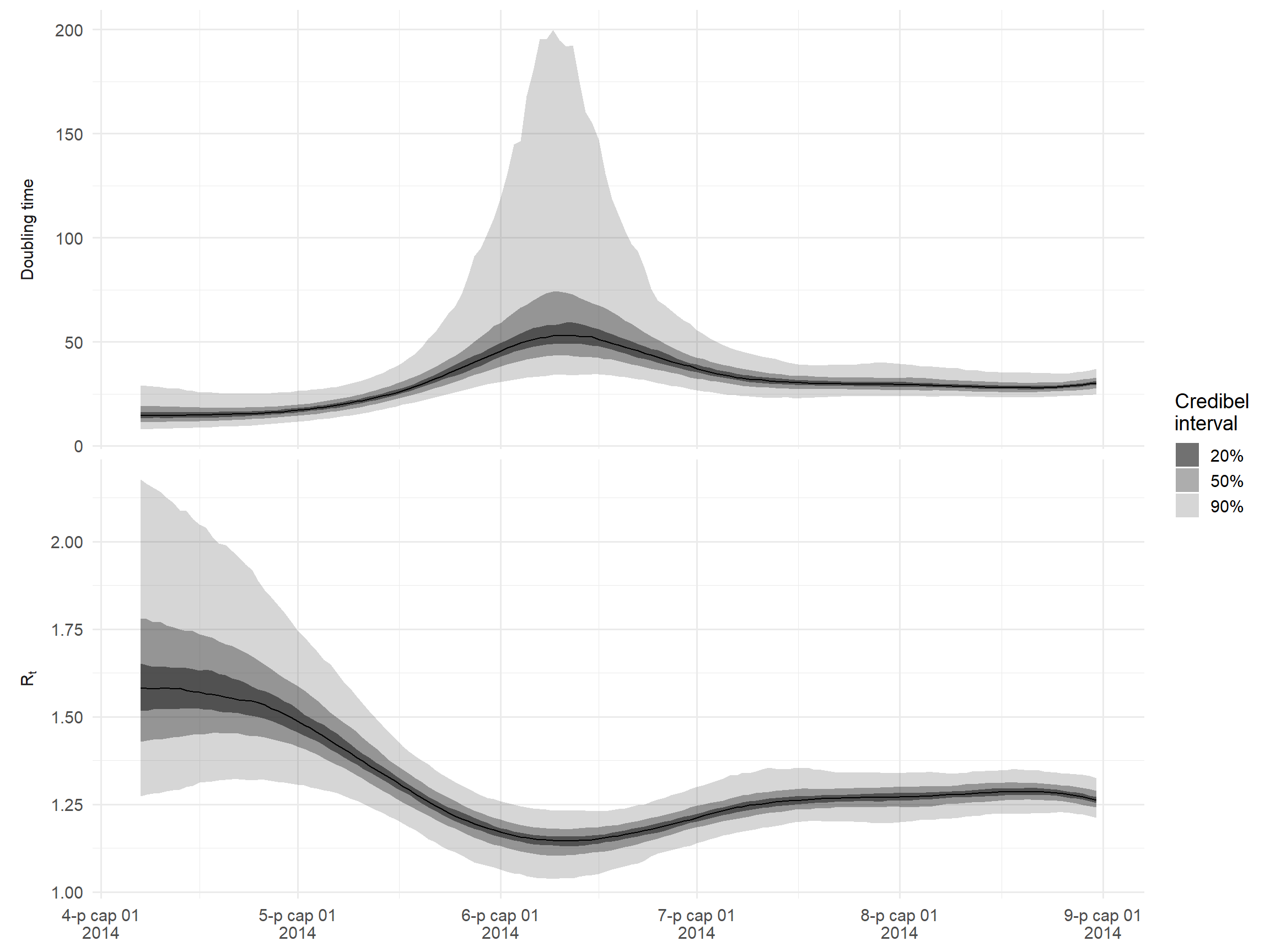
EpiEstim
To run EpiEstim, we need to provide data on daily incidence and specify the serial interval (i.e. the distribution of delays between symptom onset of primary and secondary cases).
Incidence data can be provided to EpiEstim as a vector, a data frame, or an incidence
object from the original incidence package. You can even distinguish between imports
and locally acquired infections; see the documentation at ?estimate_R for
further details.
We will create the input using incidence2. See the page on Epidemic curves for more examples with the incidence2 package. Since there have been updates to the incidence2 package that don’t completely align with estimateR()’s expected input, there are some minor additional steps needed. The incidence object consists of a tibble with dates and their respective case counts. We use complete() from tidyr to ensure all dates are included (even those with no cases), and then rename() the columns to align with what is expected by estimate_R() in a later step.
## get incidence from onset date
cases <- incidence2::incidence(linelist, date_index = date_onset) %>% # get case counts by day
tidyr::complete(date_index = seq.Date( # ensure all dates are represented
from = min(date_index, na.rm = T),
to = max(date_index, na.rm=T),
by = "day"),
fill = list(count = 0)) %>% # convert NA counts to 0
rename(I = count, # rename to names expected by estimateR
dates = date_index)The package provides several options for specifying the serial interval, the
details of which are provided in the documentation at ?estimate_R. We will
cover two of them here.
Using serial interval estimates from the literature
Using the option method = "parametric_si", we can manually specify the mean and
standard deviation of the serial interval in a config object created using the
function make_config. We use a mean and standard deviation of 12.0 and 5.2, respectively, defined in
this paper:
## make config
config_lit <- make_config(
mean_si = 12.0,
std_si = 5.2
)We can then estimate Rt with the estimate_R function:
epiestim_res_lit <- estimate_R(
incid = cases,
method = "parametric_si",
config = config_lit
)## Default config will estimate R on weekly sliding windows.
## To change this change the t_start and t_end arguments.and plot a summary of the outputs:
plot(epiestim_res_lit)
Using serial interval estimates from the data
As we have data on dates of symptom onset and transmission links, we can
also estimate the serial interval from the linelist by calculating the delay
between onset dates of infector-infectee pairs. As we did in the EpiNow2
section, we will use the get_pairwise function from the epicontacts
package, which allows us to calculate pairwise differences of linelist
properties between transmission pairs. We first create an epicontacts object
(see Transmission chains page for further details):
## generate contacts
contacts <- linelist %>%
transmute(
from = infector,
to = case_id
) %>%
drop_na()
## generate epicontacts object
epic <- make_epicontacts(
linelist = linelist,
contacts = contacts,
directed = TRUE
)We then fit the difference in onset dates between transmission pairs, calculated
using get_pairwise, to a gamma distribution. We use the handy fit_disc_gamma
from the epitrix package for this fitting procedure, as we require a
discretised distribution.
## estimate gamma serial interval
serial_interval <- fit_disc_gamma(get_pairwise(epic, "date_onset"))We then pass this information to the config object, run EpiEstim
again and plot the results:
## make config
config_emp <- make_config(
mean_si = serial_interval$mu,
std_si = serial_interval$sd
)
## run epiestim
epiestim_res_emp <- estimate_R(
incid = cases,
method = "parametric_si",
config = config_emp
)## Default config will estimate R on weekly sliding windows.
## To change this change the t_start and t_end arguments.
## plot outputs
plot(epiestim_res_emp)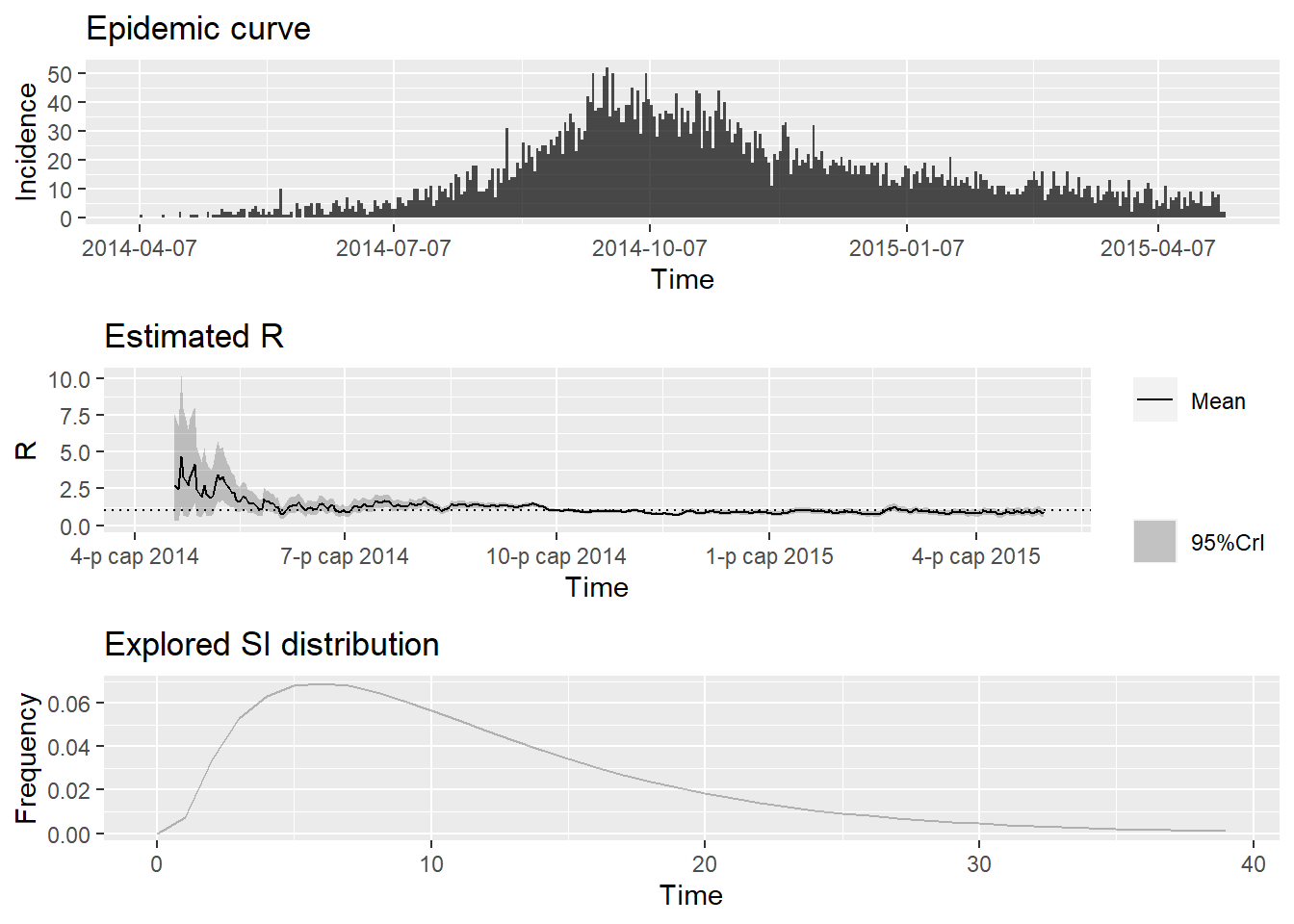
Specifying estimation time windows
These default options will provide a weekly sliding estimate and might act as a warning that you are estimating Rt too early in the outbreak for a precise estimate. You can change this by setting a later start date for the estimation as shown below. Unfortunately, EpiEstim only provides a very clunky way of specifying these estimations times, in that you have to provide a vector of integers referring to the start and end dates for each time window.
## define a vector of dates starting on June 1st
start_dates <- seq.Date(
as.Date("2014-06-01"),
max(cases$dates) - 7,
by = 1
) %>%
## subtract the starting date to convert to numeric
`-`(min(cases$dates)) %>%
## convert to integer
as.integer()
## add six days for a one week sliding window
end_dates <- start_dates + 6
## make config
config_partial <- make_config(
mean_si = 12.0,
std_si = 5.2,
t_start = start_dates,
t_end = end_dates
)Now we re-run EpiEstim and can see that the estimates only start from June:
## run epiestim
epiestim_res_partial <- estimate_R(
incid = cases,
method = "parametric_si",
config = config_partial
)
## plot outputs
plot(epiestim_res_partial)## Warning: It is deprecated to specify `guide = FALSE` to remove a guide. Please use `guide = "none"` instead.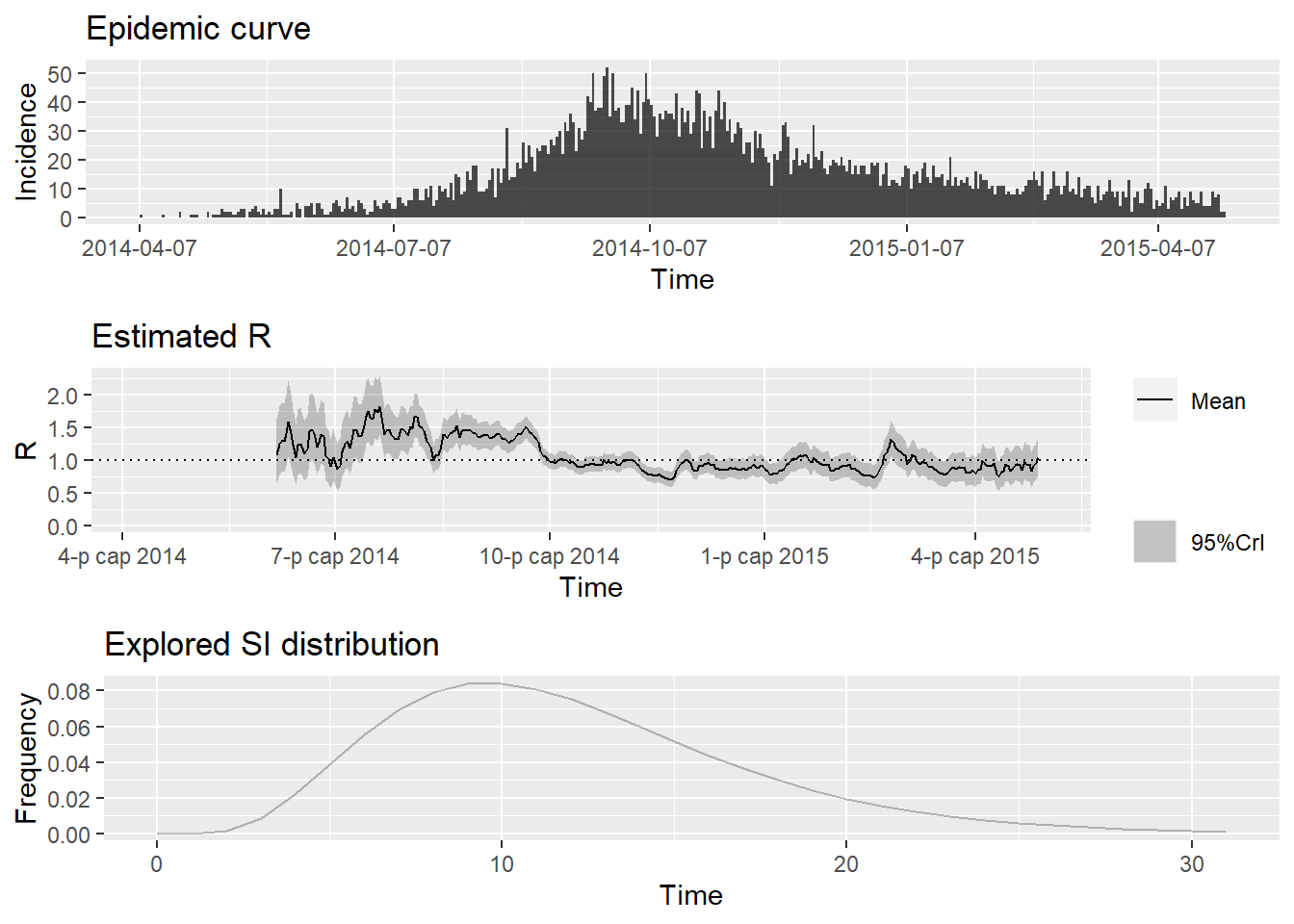
Analysing outputs
The main outputs can be accessed via $R. As an example, we will create a plot of
Rt and a measure of “transmission potential” given by the product of
Rt and the number of cases reported on that day; this represents the
expected number of cases in the next generation of infection.
## make wide dataframe for median
df_wide <- epiestim_res_lit$R %>%
rename_all(clean_labels) %>%
rename(
lower_95_r = quantile_0_025_r,
lower_90_r = quantile_0_05_r,
lower_50_r = quantile_0_25_r,
upper_50_r = quantile_0_75_r,
upper_90_r = quantile_0_95_r,
upper_95_r = quantile_0_975_r,
) %>%
mutate(
## extract the median date from t_start and t_end
dates = epiestim_res_emp$dates[round(map2_dbl(t_start, t_end, median))],
var = "R[t]"
) %>%
## merge in daily incidence data
left_join(cases, "dates") %>%
## calculate risk across all r estimates
mutate(
across(
lower_95_r:upper_95_r,
~ .x*I,
.names = "{str_replace(.col, '_r', '_risk')}"
)
) %>%
## seperate r estimates and risk estimates
pivot_longer(
contains("median"),
names_to = c(".value", "variable"),
names_pattern = "(.+)_(.+)"
) %>%
## assign factor levels
mutate(variable = factor(variable, c("risk", "r")))
## make long dataframe from quantiles
df_long <- df_wide %>%
select(-variable, -median) %>%
## seperate r/risk estimates and quantile levels
pivot_longer(
contains(c("lower", "upper")),
names_to = c(".value", "quantile", "variable"),
names_pattern = "(.+)_(.+)_(.+)"
) %>%
mutate(variable = factor(variable, c("risk", "r")))
## make plot
ggplot() +
geom_ribbon(
data = df_long,
aes(x = dates, ymin = lower, ymax = upper, alpha = quantile),
color = NA
) +
geom_line(
data = df_wide,
aes(x = dates, y = median),
alpha = 0.2
) +
## use label_parsed to allow subscript label
facet_wrap(
~ variable,
ncol = 1,
scales = "free_y",
labeller = as_labeller(c(r = "R[t]", risk = "Transmission~potential"), label_parsed),
strip.position = 'left'
) +
## manually define quantile transparency
scale_alpha_manual(
values = c(`50` = 0.7, `90` = 0.4, `95` = 0.2),
labels = function(x) paste0(x, "%")
) +
labs(
x = NULL,
y = NULL,
alpha = "Credible\ninterval"
) +
scale_x_date(
date_breaks = "1 month",
date_labels = "%b %d\n%Y"
) +
theme_minimal(base_size = 14) +
theme(
strip.background = element_blank(),
strip.placement = 'outside'
)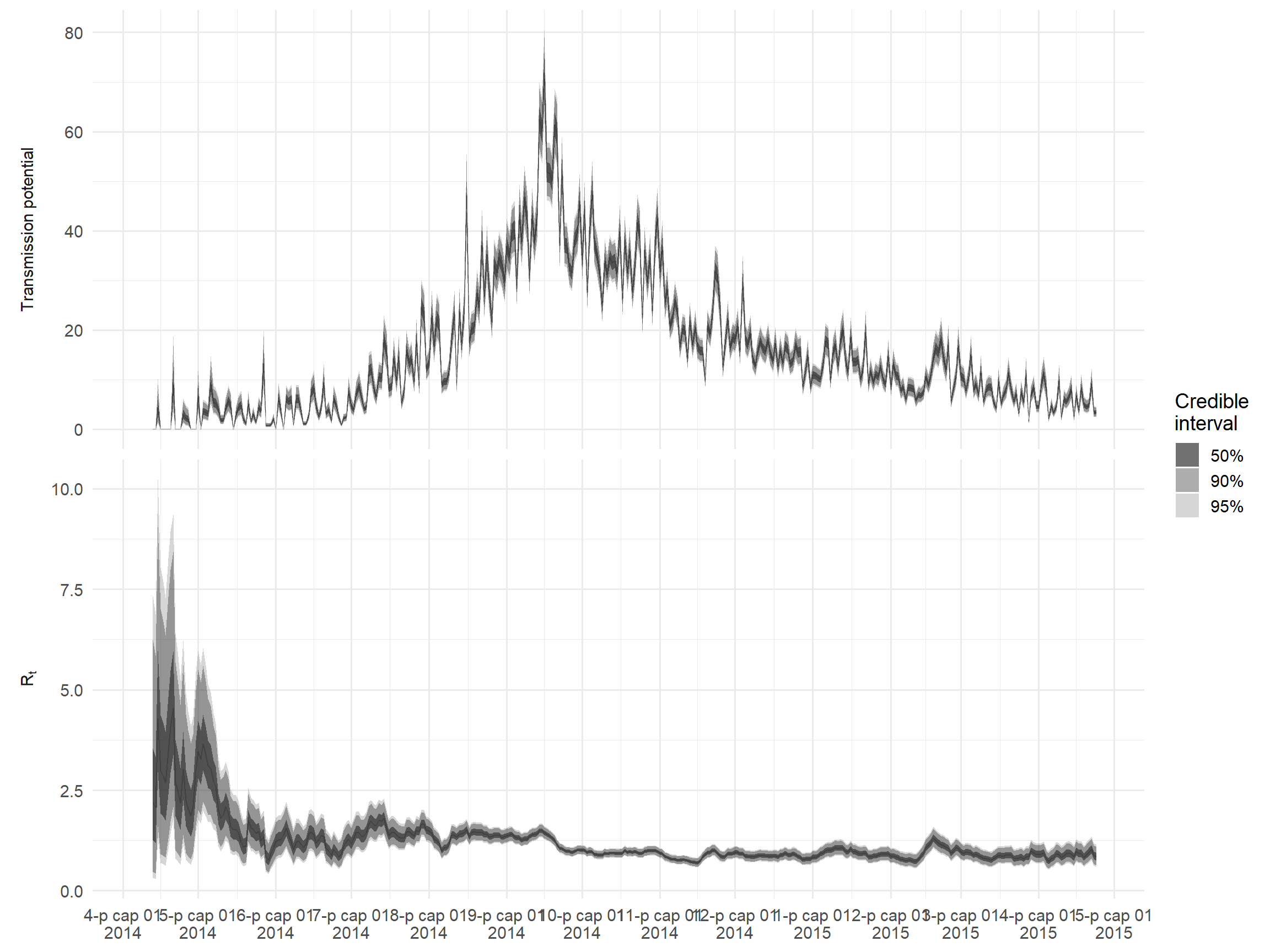
24.4 Projecting incidence
EpiNow2
Besides estimating Rt, EpiNow2 also supports forecasting of
Rt and projections of case numbers by integration with the
EpiSoon package under the hood. All you need to do is specify the horizon
argument in your epinow function call, indicating how many days you want to
project into the future; see the EpiNow2 section under the “Estimating
Rt” for details on how to get EpiNow2 up and running. In this
section, we will just plot the outputs from that analysis, stored in the
epinow_res object.
## define minimum date for plot
min_date <- as.Date("2015-03-01")
## extract summarised estimates
estimates <- as_tibble(epinow_res$estimates$summarised)
## extract raw data on case incidence
observations <- as_tibble(epinow_res$estimates$observations) %>%
filter(date > min_date)
## extract forecasted estimates of case numbers
df_wide <- estimates %>%
filter(
variable == "reported_cases",
type == "forecast",
date > min_date
)
## convert to even longer format for quantile plotting
df_long <- df_wide %>%
## here we match matching quantiles (e.g. lower_90 to upper_90)
pivot_longer(
lower_90:upper_90,
names_to = c(".value", "quantile"),
names_pattern = "(.+)_(.+)"
)
## make plot
ggplot() +
geom_histogram(
data = observations,
aes(x = date, y = confirm),
stat = 'identity',
binwidth = 1
) +
geom_ribbon(
data = df_long,
aes(x = date, ymin = lower, ymax = upper, alpha = quantile),
color = NA
) +
geom_line(
data = df_wide,
aes(x = date, y = median)
) +
geom_vline(xintercept = min(df_long$date), linetype = 2) +
## manually define quantile transparency
scale_alpha_manual(
values = c(`20` = 0.7, `50` = 0.4, `90` = 0.2),
labels = function(x) paste0(x, "%")
) +
labs(
x = NULL,
y = "Daily reported cases",
alpha = "Credible\ninterval"
) +
scale_x_date(
date_breaks = "1 month",
date_labels = "%b %d\n%Y"
) +
theme_minimal(base_size = 14)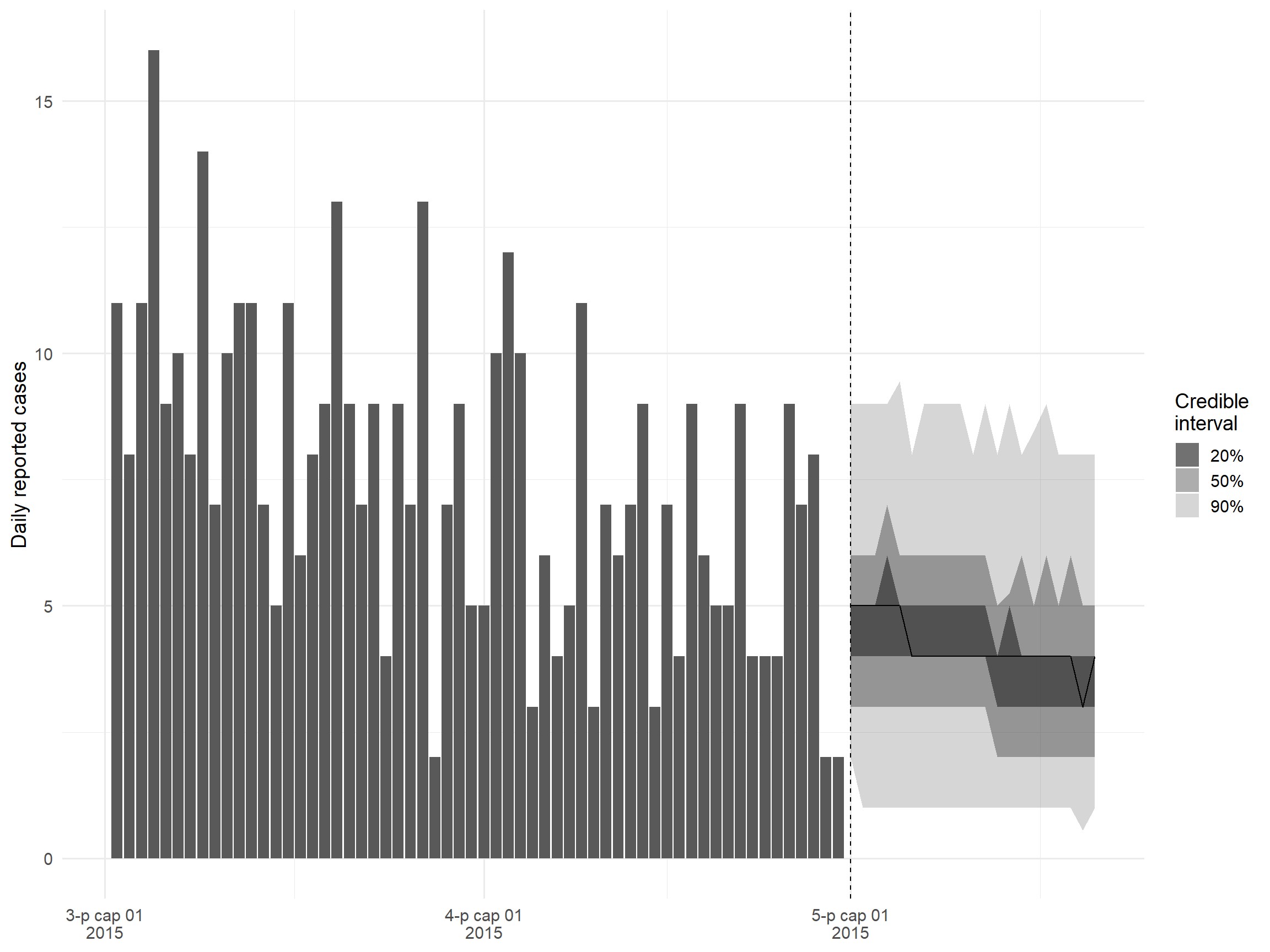
projections
The projections package developed by RECON makes it very easy to make short term incidence forecasts, requiring only knowledge of the effective reproduction number Rt and the serial interval. Here we will cover how to use serial interval estimates from the literature and how to use our own estimates from the linelist.
Using serial interval estimates from the literature
projections requires a discretised serial interval distribution of the class
distcrete from the package distcrete. We will use a gamma distribution
with a mean of 12.0 and and standard deviation of 5.2 defined in
this paper. To
convert these values into the shape and scale parameters required for a gamma
distribution, we will use the function gamma_mucv2shapescale from the
epitrix package.
## get shape and scale parameters from the mean mu and the coefficient of
## variation (e.g. the ratio of the standard deviation to the mean)
shapescale <- epitrix::gamma_mucv2shapescale(mu = 12.0, cv = 5.2/12)
## make distcrete object
serial_interval_lit <- distcrete::distcrete(
name = "gamma",
interval = 1,
shape = shapescale$shape,
scale = shapescale$scale
)Here is a quick check to make sure the serial interval looks correct. We
access the density of the gamma distribution we have just defined by $d, which
is equivalent to calling dgamma:
## check to make sure the serial interval looks correct
qplot(
x = 0:50, y = serial_interval_lit$d(0:50), geom = "area",
xlab = "Serial interval", ylab = "Density"
)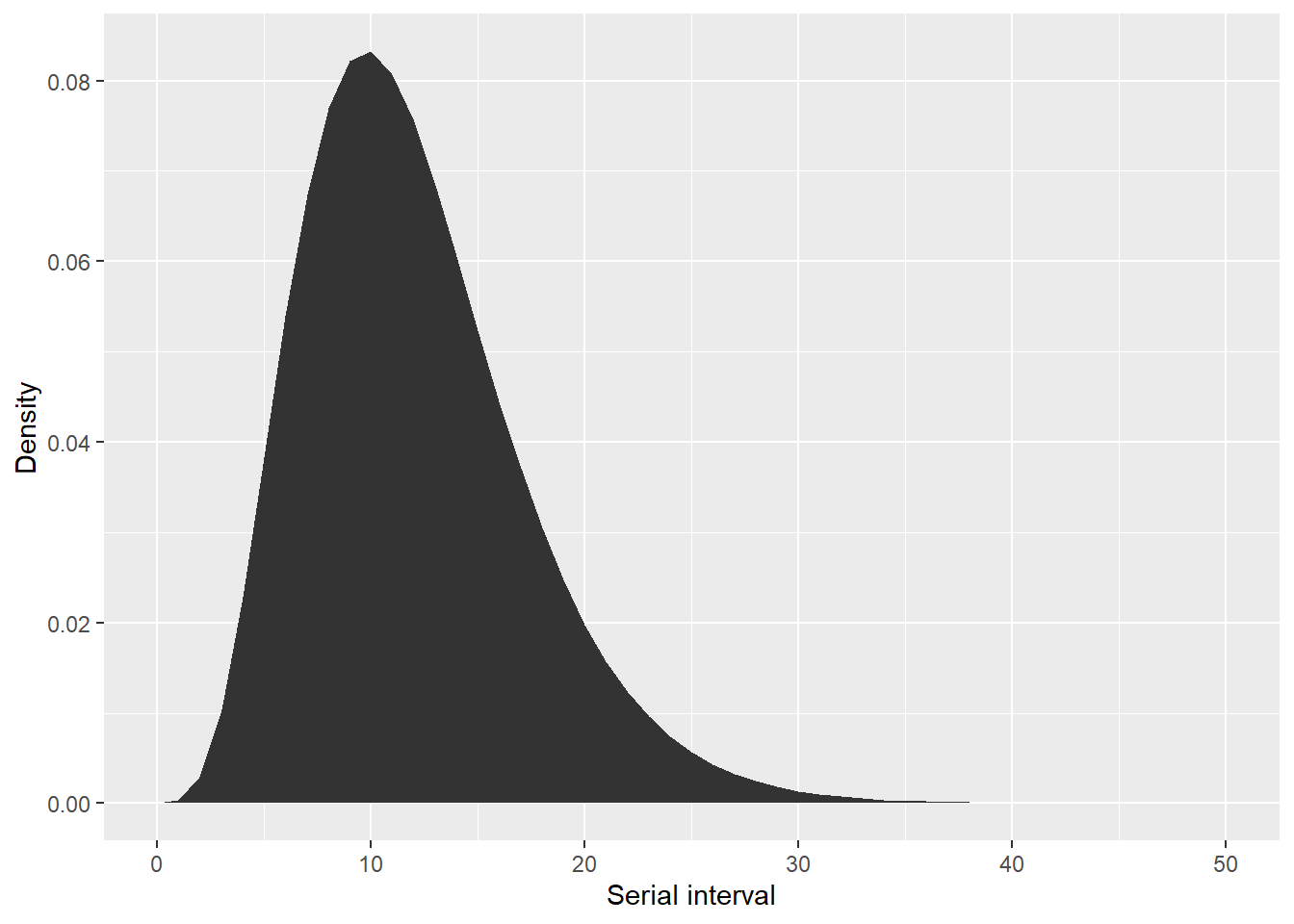
Using serial interval estimates from the data
As we have data on dates of symptom onset and transmission links, we can
also estimate the serial interval from the linelist by calculating the delay
between onset dates of infector-infectee pairs. As we did in the EpiNow2
section, we will use the get_pairwise function from the epicontacts
package, which allows us to calculate pairwise differences of linelist
properties between transmission pairs. We first create an epicontacts object
(see Transmission chains page for further details):
## generate contacts
contacts <- linelist %>%
transmute(
from = infector,
to = case_id
) %>%
drop_na()
## generate epicontacts object
epic <- make_epicontacts(
linelist = linelist,
contacts = contacts,
directed = TRUE
)We then fit the difference in onset dates between transmission pairs, calculated
using get_pairwise, to a gamma distribution. We use the handy fit_disc_gamma
from the epitrix package for this fitting procedure, as we require a
discretised distribution.
## estimate gamma serial interval
serial_interval <- fit_disc_gamma(get_pairwise(epic, "date_onset"))
## inspect estimate
serial_interval[c("mu", "sd")]## $mu
## [1] 11.51242
##
## $sd
## [1] 7.700005Projecting incidence
To project future incidence, we still need to provide historical incidence in
the form of an incidence object, as well as a sample of plausible
Rt values. We will generate these values using the Rt
estimates generated by EpiEstim in the previous section (under “Estimating
Rt”) and stored in the epiestim_res_emp object. In the code below,
we extract the mean and standard deviation estimates of Rt for the
last time window of the outbreak (using the tail function to access the last
element in a vector), and simulate 1000 values from a gamma distribution using
rgamma. You can also provide your own vector of Rt values that you
want to use for forward projections.
## create incidence object from dates of onset
inc <- incidence::incidence(linelist$date_onset)## 256 missing observations were removed.
## extract plausible r values from most recent estimate
mean_r <- tail(epiestim_res_emp$R$`Mean(R)`, 1)
sd_r <- tail(epiestim_res_emp$R$`Std(R)`, 1)
shapescale <- gamma_mucv2shapescale(mu = mean_r, cv = sd_r/mean_r)
plausible_r <- rgamma(1000, shape = shapescale$shape, scale = shapescale$scale)
## check distribution
qplot(x = plausible_r, geom = "histogram", xlab = expression(R[t]), ylab = "Counts")## `stat_bin()` using `bins = 30`. Pick better value with `binwidth`.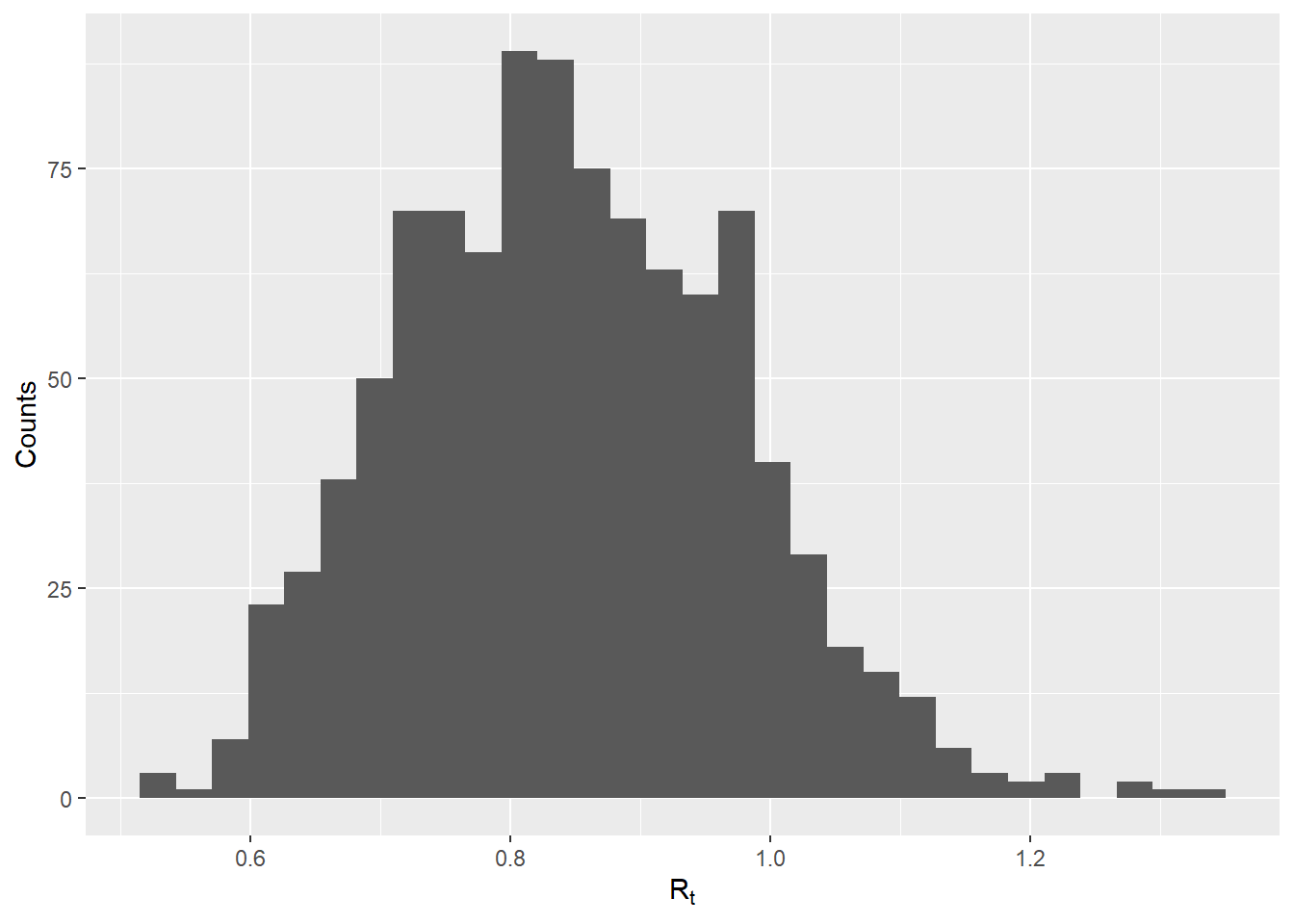
We then use the project() function to make the actual forecast. We specify how
many days we want to project for via the n_days arguments, and specify the
number of simulations using the n_sim argument.
## make projection
proj <- project(
x = inc,
R = plausible_r,
si = serial_interval$distribution,
n_days = 21,
n_sim = 1000
)We can then handily plot the incidence and projections using the plot() and
add_projections() functions. We can easily subset the incidence object to only
show the most recent cases by using the square bracket operator.
## plot incidence and projections
plot(inc[inc$dates > as.Date("2015-03-01")]) %>%
add_projections(proj)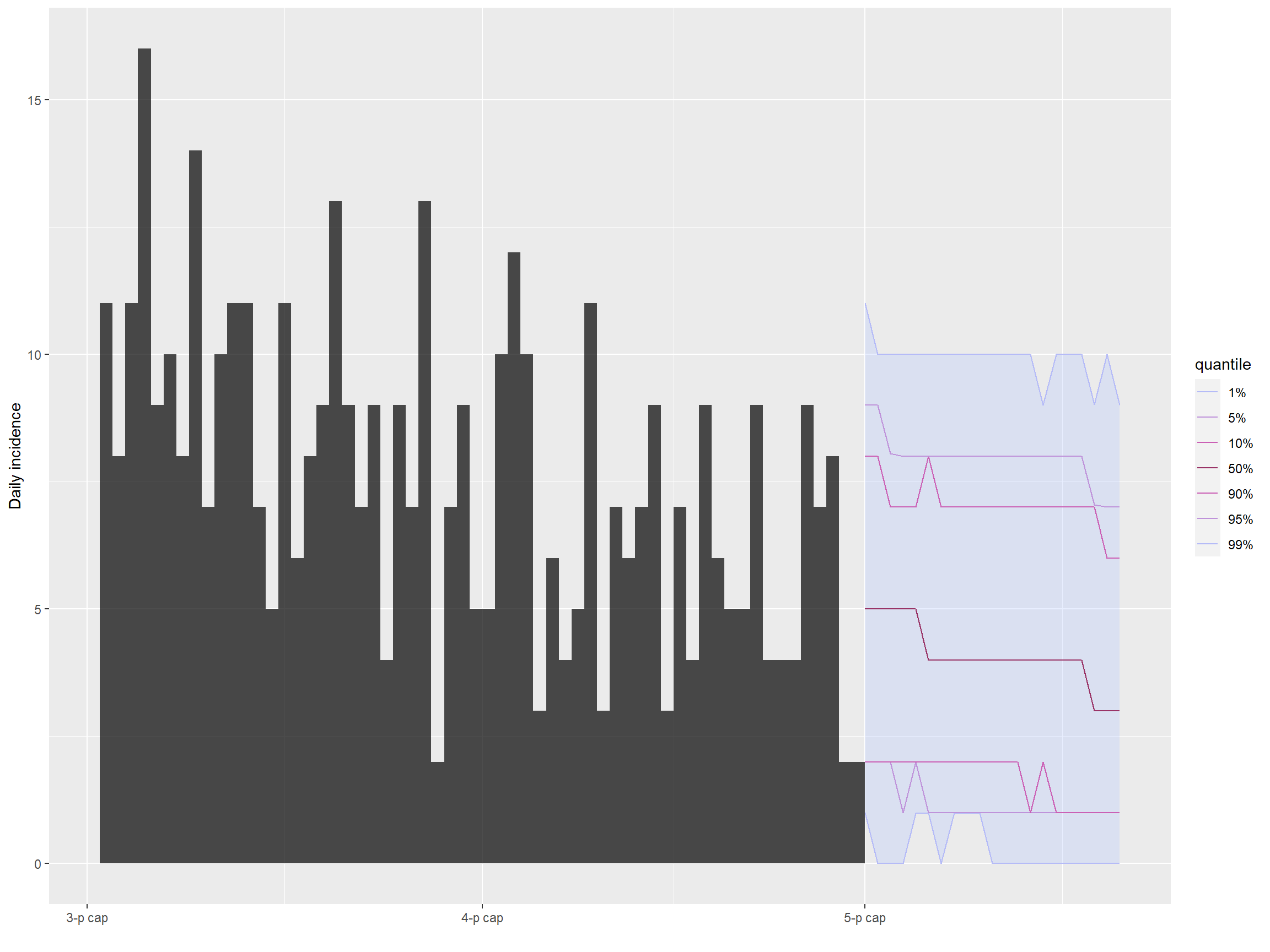
You can also easily extract the raw estimates of daily case numbers by converting the output to a dataframe.
## convert to data frame for raw data
proj_df <- as.data.frame(proj)
proj_df24.5 Resources
- Here is the paper describing the methodology implemented in EpiEstim.
- Here is the paper describing the methodology implemented in EpiNow2.
- Here is a paper describing various methodological and practical considerations for estimating Rt.